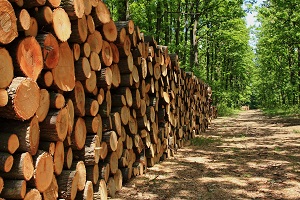
As governments worldwide impose lockdowns in an attempt to halt the spread of the coronavirus, many industries are expected to suffer the consequences. The forest sector is no exception, and this comes after couple of particularly tough years marked by a rise in pest infestations, wildfires and droughts.
Central Europe has experienced a number of dry, warmer than normal years, making spruce trees at lower elevations easy prey for bark beetles. The bark beetle epidemic has been ravaging forests in central Europe since 2018, causing log prices to fall by more than 30%, creating an over-supply of salvaged spruce logs, and calling into question the future wood supply of this region.
Experts estimated that this epidemic is likely to approach somewhere between half a billion and one billion cubic meters of wood. The forests of western North America have also been markedly affected, both by huge beetle epidemics (notably in British Columbia during the 1990s and 2000s, destroying 750 million cubic meters) and devastating forest fires, which have also been extremely disruptive in the short term and long term. These events result in an overabundance of wood followed by a reduction of future wood supply, which has already occurred in British Columbia. The 2020 fires on the west coast of the United States are estimated to have spread over more than 3 million hectares – that is about the size of Belgium. In Oregon it is estimated that the volume of trees burned is equal to about 70% to 80% of annual harvest volume.
At this year’s 78th session of the ECE Committee on Forests and the Forest Industry, experts and representatives of 44 countries gathered to discuss the nexus between a global pandemic, bark beetle infestations, forest fires and forest products, focusing on the findings from newly launched Forest Products Annual Market Review 2019-2020.
The consumption of forest products in the UNECE region was in decline for almost every forest product category in 2019, including industrial roundwood removals (-3.4%), sawnwood (-0.9%), wood-based panels (-1.5%) and paperboard (-3.5%), with the exceptions of fuelwood (+4.4%) and wood pellets (+3.3%). With the threat of COVID-19 looming large over the global economy, the expectations were that the disruptions associated with the pandemic, and related drop in global GDP, would have a devastating impact on the production and consumption of forest products.
However, despite falling GDPs in the region and work disruptions, the experts participating in the Market Discussions noted that forest products have proven surprisingly resilient and even more surprisingly, prices for sawn softwood have hit all-time records in North America, driven by pent-up housing demand. More information on these developments, as well as forecasts for 2020 and 2021, are available here.
Theories as to why forest product markets have stayed buoyant abound, with anecdotal information suggesting that working from home and travel restrictions have enabled more spending and time for do-it-yourself projects, as well as a need for home furnishings and modifications for home offices. Experts at the meeting noted that pent-up demand for housing within the UNECE region and demand for forest products from countries with growing populations and economies are likely to fuel strong demand through the decade. Moreover, demand for low carbon building solutions and systems that enable off-site modular construction, such as cross laminated timber, will continue to grow exponentially.
The expert discussions at the 78th session also noted that the COVID-19 outbreak poses less of a threat to the future demand for wood products, than dangers forests face as a result of climate change, insect epidemics and forest fires. While climate change is an important part of the problem causing increased insect infestation and fires, a considerable component of this problem is caused by current forest management methods, which can be addressed immediately.
Mr. Florian Steierer, Economic Affairs Officer at the UNECE/FAO Forestry and Timber Section who led the preparations of the Forest Annual Market Review 2019-2020 and the Market Discussion of the Committee, observed that: “2020 has proven to be a surprising year – not only because COVID-19 did not have the devastating consequences that we all feared; but because we have instead focused on an issue of longer term significance – the future of our raw materials, which is under threat and not all of it is the fault of climate change. Some of it is our fault and calls for a better understanding of how best to manage forests for the provision of wood products into the future.”
Note to editors:
Forest Products Annual Market Review can be accessed here. http://www.unece.org/forests/fpamr2020.html
Country Market Statements (economic trends of forest products submitted by countries) can be accessed here. http://www.unece.org/forests/market-statements-2020.html
Forecast tables (first estimates for forest products market trends in 2020 and 2021) can be found here. http://www.unece.org/forests/fpm/timbercommittee.html
UNECE Committee on Forests and the Forest Industry Market Statement: https://www.unece.org/DAM/timber/statsdata/market-statement-coffi78-as-of-2020-11-06.pdf